
Chitactac Adams—Uvas—Chesbro County Parks |
| Field-trip overview: This field trip provides opportunity to examine rocks typical of the southern foothills of the Santa Cruz Mountains. Stop 1 is to examine geologic and archeological features at Chitactac-Adams Heritage County Park. Stop 2 to is to examine the stream valley and rocks exposed in the spillway at Uvas Dam. Stop 3 is to examine rocks and soil exposed along the shore of Uvas Reservoir. Stop 4 is to examine rocks, landscape features, and ecology of the Chesbro Dam area. |
 |
| Geologic Setting: Compared with other mountain ranges in the United States, the Santa Cruz Mountains are relatively very young. Marine fossils found high in the mountains show that much of the mountainous region was under the ocean as little as 4 to 5 million years ago. Rocks exposed in the eastern foothills mostly consist of ancient oceanic crust (igneous and metamorphic rocks) and sedimentary rocks formed from sediments deposited far offshore in the deep ocean basin to sediments deposited in mid-level to shallow continental shelf environments. The forces associated with plate tectonics are actively changing the landscape. The Santa Cruz Mountains are rising due to tectonic compressional forces associated with the regional fault system. The San Andreas Fault is the largest and most obvious based on earthquake data and features observable on the landscape. However, other active earthquake faults and older (extinct, dormant, even undiscovered) faults run through the eastern foothills of the Santa Cruz Mountains. The mountains are rising only slightly faster that weathering and erosion is wearing down the landscape. The foothills are characterized by deep canyons, some roughly follow the trace of fault zones where the bedrock is broken up and more rapidly eroded. Dams installed to manage water supply and control flooding are also traps for sediments moving downstream. The landscape in the eastern foothills is also host to a variety of plant habitats, with special note to plants associated with serpentinite soils. Serpentinite is one of the common rocks found in the foothills region. |
|
| Map of southern Santa Clara County showing the location of selected field-trips stops in the foothills west of Gilroy and Morgan Hill, California. (Map modified from a parks map by the Santa Clara County Parks and Recreation Department. |
Stop 1—Chitactac-Adams Heritage County Park: The park is four-acre park site is located on Watsonville Road between Gilroy and Morgan Hill. The park features rock exposures with archeological features (petroglyphs and mortar holes) carved by ancestral Ohlone Indians. The park includes a self-guided interpretive walk and an interpretive shelter focusing on Ohlone Indian culture and the Adams schoolhouse which was sited on this property from the 1850s until 1956. |
Click on images for larger view |
|
 |
||
| Indian mortar holes and spiral petroglyph carvings | ||
 |
||
| Tafoni weathering creates unusual-shaped outcrops in the Vaqueros Sandstone outcrops along Uvas Creek |
||
Stop 2—Uvas Reservoir Dam: Uvas Reservoir is located in the foothills below the Santa Cruz Mountains west of the City of Morgan Hill. Upon leaving Chitactac-Adams, turn left on Watsonville Road. Proceed north 2.4 miles and turn left on Uvas Road (continuing on County Route G8).
Proceed north on Uvas Road 4.3 miles to roadside parking next to Uvas Dam. This stop is to examining the geologic setting of Uvas Dam. (The word uvas means "grape" in Spanish. Early Spanish settlers found wild grapevines in the area.) Two brief stops are recommended. One stop is a pull off on the right side (south side) of Oak Glen Road near the intersection of Llagas Road. Outcrops of weathered dark red-layered chert can be seen along road cuts. This site is near the location where Llagas Creek flows into the reservoir. During low water levels the creek is a delightful place to wade to look at the gravel in the creekbed. This next stop is at the boat dock parking area. A short walk along Oak Glen Road leads to a path that the dam and into the valley below. Outcrops along Oak Glen Road and on the north end of the dam consist of serpentinite. |
 |
|
| View of Twin Peaks along the Watsonville Road near Chitactac-Adams County Historical Park | ||
 |
||
| Pillow basalt exposed at the base of Uvas Reservoir Dam | ||
 |
||
| View looking northwest from Uvas Reservoir Dam toward the location of Stop 3 at the park picnic area. The linear-shaped valleys basically follow the traces of faults cutting through the Uvas Valley area. |
||
 |
||
| Loma Prieta, the highest peak in the Santa Cruz Mountains, as seen from Chesbro Reservoir | ||
 |
||
| Chesbro Dam | ||
 |
||
| Serpentinite near Chesbro Dam with Manzanita forest | ||
Morgan Hill poppy jasper: The Morgan Hill area is historically famous for its "poppy jasper." Poppy jasper is a varity of "orbicular chert"—a hard, metamorphic variety of silica-rich rock (chert) that has ring-like bands or spots of red, orange, yellow, and white. These are imbedded in a matrix of similar chert ranging in color from red, orange, yellow, to black. Several varieties of poppy are found throughout the foothills of the Santa Cruz Mountains. A famous mine locality in Morgan Hill produced a large amount of poppy jasper in the first half of the 20th century. The rock was sought after by lapidary and jewelry craft and much of what is commercially available today came from that mine (long closed to production). Poppy jasper is still reported by local collectors, but getting access to collecting sites is nearly impossible on private land. The orbicular jasper is likely formed by the metasomatic alteration of vesicular volcanic rock. Hot fluids carrying dissolved silica and iron migrating through porous volcanic rock filled in the holes with iron minerals and silica. |
 |
|
| Morgan Hill poppy jasper | ||
| Selected Reference Information: Stoffer, P.W. and Messina, P., 2002, Field-Trip Guide to the Southeastern Foothills of the Santa Cruz Mountains In Santa Clara County, California: U.S. Geological Survey Open-File Report 02-121: U.S. Geological Survey Open-File Report 02-121, 29 p. Available online at: http://geopubs.wr.usgs.gov/open-file/of02-121/of02-121.pdf McLaughlin, R.J., Clark, J.C., Brabb, E.E., Helley, E.J., and Colón, C.J., 2002, Geologic Maps and Structure Sections of the Southwestern Santa Clara Valley and Southern Santa Cruz Mountains, Santa Clara and Santa Cruz Counties, California: U.S. Geological Survey, Miscellaneous Field Studies MF–2373, 8 plate (maps with cross sections) and technical report. Available online at: http://pubs.usgs.gov/mf/2002/2373/
|
||